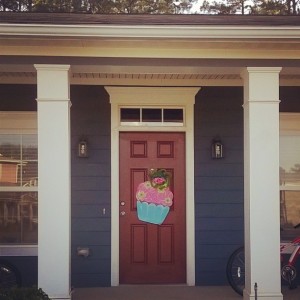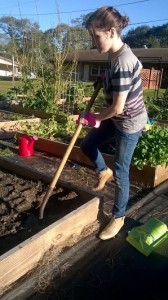We recently moved into a new home here in South Georgia, and because we moved on base, it’s like having an HOA except we don’t have to pay fees to have them tell us what we can and can’t do with our home and we don’t outright own our home either. We will live here for at least two more years and then be moved to our next duty station. Due to the nature that most families don’t often live here for more than four years, there’s a company that is hired to take care of our landscaping around our home and with the exception of potted plants, we don’t really have a say.

Thankfully, Kelley Hall, one of the ladies that work on base here proposed a community garden and secured a grant to pay for the materials to build it. She and a team of military spouses built elevated beds, secured fencing, and even put in a compost area for us to use. Even though I haven’t gardened since I was a young child with my family, I could not let a community resource like this go to waste, nor the opportunity to teach my children where their food comes from and how it grows. I also never gardened in the winter in my home state of Pennsylvania, so this was all new to me.
The first thing I did was research to see what would be the easiest to grow for our first winter garden in South Georgia. I took into consideration that there would be some very low temperatures occasionally, but also noted that this year has been very mild. I chose lettuce, carrots, and cabbage to start with. Because our garden plot is on a raised bed, the sun will warm the soil more quickly, which is important because there is less sunlight during the winter. A cold frame or mulch can also be helpful in keeping the soil warm. I also found that I will have to water less due to the fact there aren’t high heat temperatures to deal with, which in turn, I will also have to weed less. I have also decided to plant a potted tomato plant, but I will be keeping that one in the home with us.

I chose our planting date based on frost warnings and roughly how long it would take my plants to mature. Sadly, it frosted during that time, so I may not end up with a strong harvest this time. But, next year, I will be sure to get my plants in the ground way sooner in the fall and I’m sure I will have a few more lessons to learn before this is all over, such as using quilted row covers to protect our plants from the cold temperatures and bugs. I also may germinate my plants in the house so that our children learn about germination before we plant. Next year, we may also decide to go with planting roots instead, such as turmeric or ginger, as they seem even easier to deal with and we can get away with planting a little later into the season as well and harvest in the spring. These types of plants can be planted even after the first frost, though if the ground is hard we may have to mix in some compost and peat moss to make the ground more friable.
Despite our possible hiccups this year, I’m excited to see how our first attempt at winter gardening will end. Will we get anything to grow or will it be a huge bust? Either way, I know our family will learn a lot and take it into account next winter. When you have four children, you have to try saving any way you can, and spending $12 on seeds to plant several times is certainly more affordable than spending $12 on organic vegetables from the store to eat at one meal. Did anyone else plant a winter garden this year?



